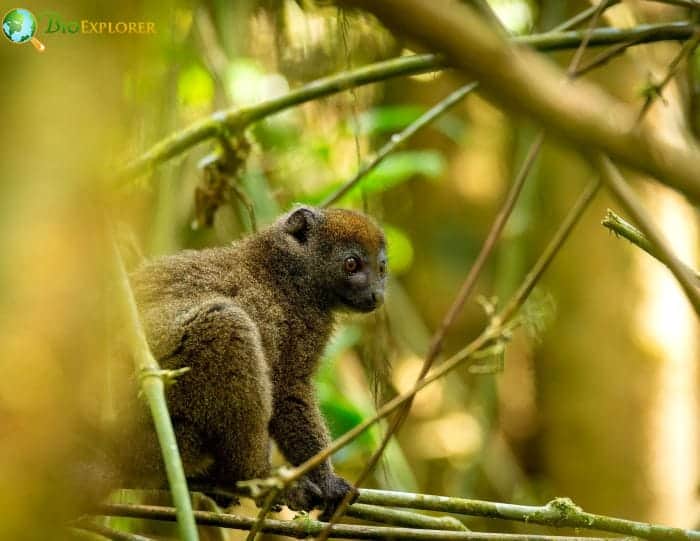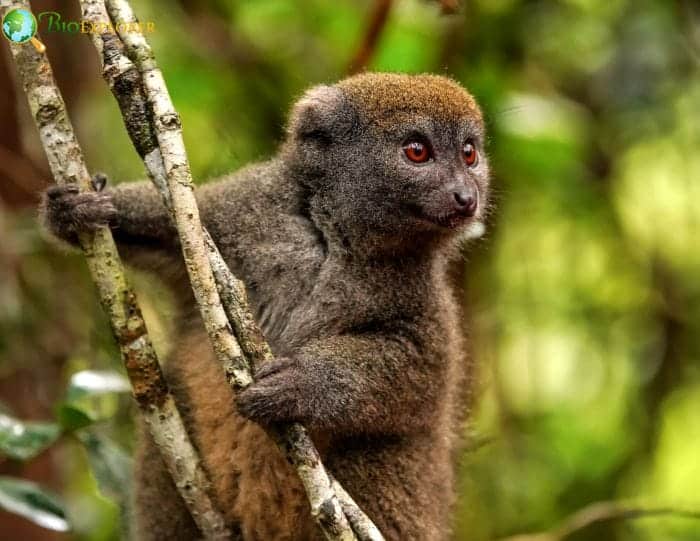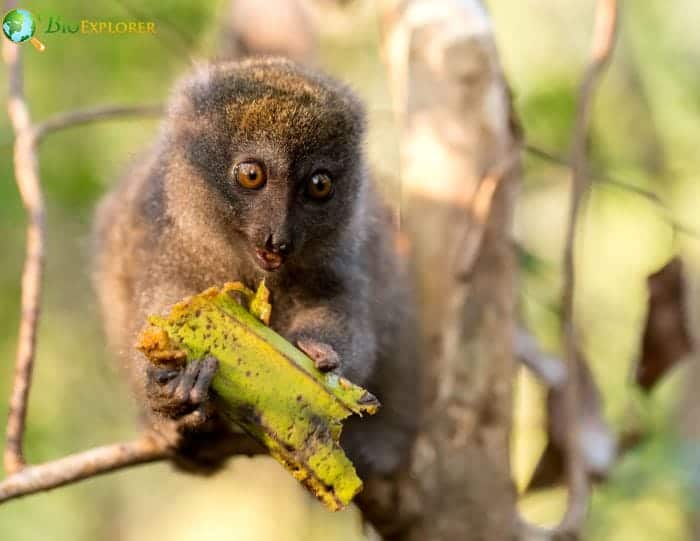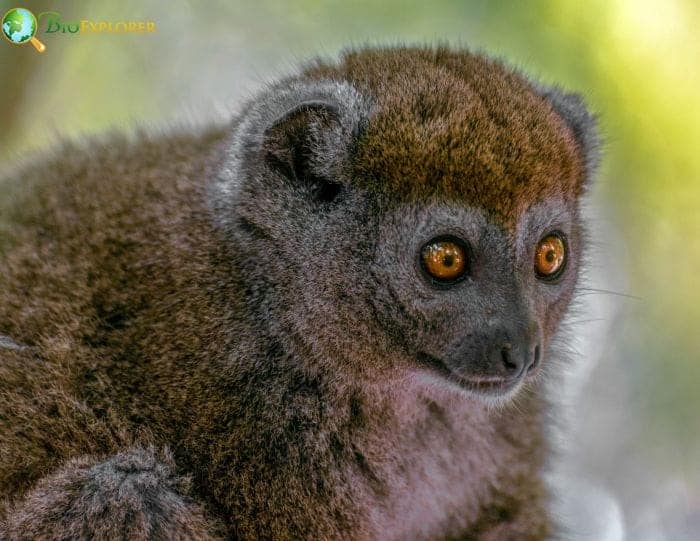
| Animalia | Mammalia | Primates | Lemuridae | Chordata | Hapalemur griseus |
The eastern lesser bamboo lemur (Hapalemur griseus) is a fascinating primate endemic to the island nation of Madagascar. Despite its small size and cryptic nature, this unique lemur has captivated scientists and conservationists with its incredible ecological adaptations.
As its name indicates, the eastern lesser bamboo lemur relies heavily on various bamboo species to sustain itself. Its bamboo-dominated habitat has molded its physical traits, movement patterns, social structure, and survival.
This comprehensive article will explore what makes the eastern lesser bamboo lemur special. Key topics covered include:
- Overview of the animal, its taxonomy, and conservation status.
- Physical adaptations to a bamboo diet.
- Locomotion through bamboo forests.
- Feeding ecology and specialized teeth.
- Behavior, reproduction, and social groups.
- Threats to survival and conservation priorities.
Whether a casual reader looking to learn more or a researcher seeking the latest data, this piece aims to provide extensive detail on this vulnerable bamboo-eating specialist of Madagascar’s endangered forests.
![]()


- Common Name: Eastern Lesser Bamboo Lemur
- Taxonomy Classification Year: 1795
- Monkey Size: 26 to 46 cm (10.2 to 18.1 inches)
- Skin Color(s): Grey-brown
- Habitat: Forests
- Diet: Herbivorous
- Native Countries: Madagascar
Eastern Lesser Bamboo Lemur Characteristics

The eastern lesser bamboo lemur is the smallest member of the genus Hapalemur, part of the greater lemur family. It averages just 11 inches (284mm) in head-to-body length with a 1.5-inch (36.6mm) tail and weighs approximately 1.5 to 2 pounds (700-900 grams).
Its fur is grayish overall, sometimes with a reddish-toned patch on the head. Identifying features include a lack of ear tufts which other bamboo Lemurs possess.
The eastern lesser bamboo lemur goes by several common names, including Gray bamboo lemur, Gray gentle lemur and Mahajanga lemur.
Its scientific name is Hapalemur griseus. This species has three recognized subspecies:
- H. g. griseus The nominate subspecies first described in 1795 by German naturalist Johann Friedrich Link.
- H. g. ranomafanensis Named for its presence in Ranomafana National Park in southeast Madagascar.
- H. g. gilberti Also called Gilbert’s gentle lemur, after French primatologist Alain Gilbert.
Despite no definitive overall population estimates across its range, the International Union for Conservation of Nature (IUCN) Red List categorizes the eastern lesser bamboo lemur as vulnerable to extinction. Its numbers are decreasing primarily due to:
- Habitat loss as forests is cleared for agriculture and timber.
- Hunting for bushmeat and the pet trade.
Exact population sizes are uncertain, but research conducted in Ranomafana National Park from 2004-2009 uncovered:
- 818 individuals of the H. g. griseus subspecies residing in the reserve.
- An estimated population decline occurring even within federally protected park areas.
So, while legally protected under Malagasy law and included in some national parks, the eastern lesser bamboo lemur remains at heightened risk from threats of encroaching habitat. Protecting it in practice has proven an ongoing challenge for conservation groups.
The eastern lesser bamboo lemur is a small, agile primate exquisitely adapted to life amongst bamboo thickets and vines. It displays several unique physical and behavioral characteristics shaped by its specialized bamboo diet, as we will explore further.
![]()
Eastern Lesser Bamboo Lemur Distribution

The eastern lesser bamboo lemur belongs to the taxonomic order Primates and the family Lemuridae, which contains all lemurs endemic to Madagascar. More specifically, it is grouped under the genus Hapalemur.
This genus contains several other bamboo lemur species including the Golden Bamboo Lemur (Hapalemur aureus) and the greater bamboo lemur (Hapalemur simus). At just 11 inches long, the eastern lesser bamboo lemur is the smallest member of the Hapalemur genus.
Its geographic range predominantly covers lowland and mountain rainforests in northeastern and eastern Madagascar. However, the three recognized subspecies each occupy different forest habitats across the island:
- H. g. griseus Lives in forests along the eastern coast and isolated forests further north. The nominate subspecies with the widest distribution.
- H. g. ranomafanensis Occupies southeastern tropical rainforests of the Ranomafana region.
- H. g. gilberti Resides in east-central Madagascar just south of the Mangoro River.
Conservation efforts have focused on establishing protected areas like Ranomafana National Park, which provide refuge to eastern lesser bamboo lemur subpopulations. Unfortunately extensive habitat loss continues in unprotected and lesser-known forest regions.
Maintaining connectivity between isolated forest fragments across its range will be vital for the long-term survival prospects of Hapalemur griseus. Protecting existing corridors of bamboo habitat is a crucial conservation priority. Comprehensive surveys to map the distributions of the three subspecies would also aid future management plans.
The eastern lesser bamboo lemur can be pulled back from the brink of endangerment by preserving intact forests that allow the continuation of its unique bamboo-dominant ecological niche.
![]()
Eastern Lesser Bamboo Lemur Habitats

The eastern lesser bamboo lemur is intimately dependent on bamboo for its survival. It lives almost exclusively in dense bamboo thickets and vines within primary rainforests.
- Research suggests groups will starve if they lose access to the bamboo patches flourishing in their home ranges. Even small forest fragments will support lemur populations provided adequate bamboo is present.
- The species is morphologically adapted to move vertically through the bamboo stalks it depends on. It is an agile vertical clinger and leaper, rapidly ascending, descending, and jumping sideways between upright bamboo culms.
- H. griseus utilizes more standard, quadrupedal locomotion on horizontal branches or the ground. But awkward, shuffling ground movement suggests its arboreal specializations.
- The eastern lesser bamboo lemur displays greater manual dexterity and precise hand-eye coordination than most lemurs. It can firmly grip bundles of bamboo with customized hand proportions. This allows twisting, turning and manipulating the woody stalks into position for harvesting new shoots.
- The species’ survival is wholly premised on the continued growth of the appropriate bamboo within intact rainforest ecosystems. Remove or diminish this essential resource, and the lemur disappears as well. So, conserving existing old-growth tropical forests remains paramount.
![]()
What Do Eastern Lesser Bamboo Lemurs Eat?

As a bamboo lemur, the eastern lesser bamboo lemur is a dietary specialist, feeding almost exclusively on various bamboo species. Research conducted in Ranomafana National Park found:
- 72% of feeding time concentrated on giant bamboo (Cathariostachys madagascariensis).
- 16% spent on other bamboo grasses and shoots.
- Only 12% on non-bamboo plants like figs or leaves.
The lemurs prefer the bases of new shoots, and leaf sheathes with more protein and nutrients. Their specialized teeth help sever and crush the fibrous stalks to access the inner pith.
- Notable dental adaptations include: Enlarged lower incisors for scraping. Robust upper canines for cutting stalks. A sizeable second premolar for crushing bamboo. Jaw muscles have increased bite force compared to other lemurs.
- These modifications allow H. griseus to exploit the ubiquitous but woody bamboo. Other lemurs struggle to extract nutrients from mature stalks.
- Yet bamboo contains taxing plant defenses like cyanide compounds, for which the eastern lesser bamboo lemur has evolved a high toxin tolerance. It feeds heavily on normally inedible shoots.
So, this species survives on a nutritionally strained, dangerously toxic diet. But by specializing, it exploits an endless niche other primates cannot fill. No sympatric lemurs directly compete for their niche. Tradeoffs enable monopoly overabundant resources other animals cannot consume.
![]()
Eastern Lesser Bamboo Lemur Behavior & Social Structure

The eastern lesser bamboo lemur exhibits behavior and social patterns closely aligned with its bamboo-centric diet.
- The activity follows a cathemeral pattern, with more directed activity in the mornings and evenings bracketing a midday rest period. This matches circadian rhythms of bamboo palatability and nutrient availability.
- Lemurs live in small family groups averaging 4-5 individuals, usually an adult male-female pair and offspring. The adult female often forages alongside juveniles while the male remains peripheral.
- Mating occurs during the May-June early dry season. After a 137-day gestation, a single infant is born each September. Infants are parked while mothers forage and carried in the mouth until weaned around 4 months old.
- Interspecies interactions center on differing bamboo exploitation strategies compared to the greater and golden bamboo lemurs. The eastern lesser bamboo lemur feeds on smaller, lower-quality shoots, likely to avoid direct resource competition.
- While social, sleeping groups huddle together for warmth. Predator mobbing sees groups band together to drive off raptors. So, their extreme ecological specialization exists alongside cooperative familial ties.
![]()
What Eats Eastern Lesser Bamboo Lemurs?

In the eastern forests of Madagascar, the eastern lesser bamboo lemur faces a range of native and introduced predators:
Native Predators
- Boa constrictors These heavy-bodied snakes are known to prey on multiple lemur species.
- Madagascar serpent eagles An endemic bird of prey observed feeding on H. griseus.
- Potentially fossas Cat-like carnivores, likely predators though not directly observed.
- Potentially feral dogs Could hunt lemurs struggling outside fragmented forests.
Introduced Predators
- Humans hunting for bushmeat Lemurs trapped using snares or shot for illegal wild meat.
- Domestic cats and dogs Attack and kill lemurs encroaching on villages.
But habitat destruction poses an even greater, longer-term threat across the species’ restricted range.
- Agricultural conversion and timber harvesting continue to fragment once-intact tropical forests rapidly. This isolates lemur family groups from each other and degrades the essential bamboo thickets they depend upon for sustenance.
- International illegal trade has also fueled the capture of lemurs like H. griseus for the exotic pet business. And climate change brings unpredictable impacts increased storms, droughts, and fires that could profoundly alter forest composition.
- With highly specialized ecological needs and relatively low total population numbers, the eastern lesser bamboo lemur remains extremely vulnerable to these exacerbated anthropogenic threats. Their concentrated presence in protected areas like Ranomafana National Park offers some respite.
However, continued habitat conservation in and outside federal reserves is desperately needed to ensure adequate bamboo resources remain to sustain viable lemur populations.
![]()
Eastern Lesser Bamboo Lemur Conservation Status and Protection

The eastern lesser bamboo lemur is classified as Vulnerable on the IUCN Red List of Threatened Species. This means it faces a high risk of extinction in the wild.
Legal hunting and capture are prohibited under Malagasy law. The species is also listed under Appendix I of CITES, banning all international trade.
A national species action plan exists, outlining key conservation strategies:
- Protect forests harboring H. griseus populations.
- Restore degraded habitats to boost bamboo density.
- Conduct population monitoring and threaten assessments.
- Raise local community awareness on conservation.
In practice however, meaningful protections still need to be improved outside a few national parks. Enforcing environmental laws in remote regions continues to prove incredibly difficult.
- For the endangered eastern lesser bamboo lemur, the outlook remains tenuous.
- While some subpopulations find refuge in reserves like Ranomafana, many reside beyond park boundaries in unprotected forests.
- Their specialized bamboo diet cannot sustain them if too much habitat disappears.
Thus, ensuring the species’ long-term survival requires expanded environmental protections for remaining intact forests across Madagascar’s eastern reaches. Only this will preserve the lemur’s essential niche and the full diversity of Madagascar’s natural heritage.
![]()
Importance of the Eastern Lesser Bamboo Lemur

The eastern lesser bamboo lemur is a vital part of Madagascar’s one-of-a-kind natural heritage that evolved over eons of isolation. Reasons we must protect this endangered species include:
- Acts as an indicator species for the health of Madagascar’s delicate rainforest ecosystems.
- Plays a unique functional niche in consuming technically inedible bamboo that most other species cannot exploit.
- Provides genetic and evolutionary data as an ancient primate lineage member.
- Has ecotourism potential for visitors to protected parks seeking endangered wildlife.
- Possesses inherent value as a fascinating product of Madagascar’s rich natural history separate from human interests.
- Makes up an irreplaceable piece of Earth’s interdependent biodiversity.
- Signals an increasing environmental crisis amid worsening extinctions.
In summary, the eastern lesser bamboo lemur merits ecological, economic, scientific, and ethical protection. Losing this narrowly distributed species permanently diminishes global natural heritage while damaging interconnected biological systems close to collapse.
![]()
Eastern Lesser Bamboo Lemur Fun Facts

- Safely eats bamboo containing cyanide, a toxic compound lethal to most species. It has evolved adaptations allowing it to ingest the natural poison regularly.
- Possesses superior manual dexterity compared to other lemurs, firmly gripping and manipulating woody bamboo stalks using specialized hand proportions.
- Rapidly moves through treetops by vertically leaping between upright bamboo culms, aided by strong limbs and grasp. Often described as an agile “vertical clinger and leaper”.
- Takes regular midday naps up to a few hours long, conserving energy during warmer daylight periods when bamboo shoots tend to be less palatable.
- Infant lemurs instinctively “park” themselves on branches when mothers are busy foraging, waiting patiently for hours until she returns.
- Lacks conspicuous ear tufts present in its closest relatives, the greater and golden bamboo lemurs. It makes it the only bamboo lemur without these furry elongated ear tips.
- Feeds on narrower bamboo shoots averaging just 0.85 cm in diameter, smaller than greater (6 cm) or golden (2.1 cm) bamboo lemurs preferentially consume.
- Fills a unique niche not directly competed over by other lemur species in Ranomafana National Park, likely because it eats smaller, lower-quality shoots.
- Active pattern follows a cathemeral schedule, with peaks early morning and late afternoon plus resting around midday. This appears synchronized with daily bamboo shoot palatability.
- Lives in tight-knit family groups of just 4-5 individuals on average, comprising a mated pair and several offspring.
So, while seemingly small and innocuous in appearance, the eastern lesser bamboo lemur remains a distinctly specialized primitive primate – the solitary lemur adapted to exploit abundant but extremely bitter bamboo. Its unique traits and behaviors reflect a one-of-a-kind, ancient lineage demanding greater efforts at preservation.
![]()
Frequently Asked Questions

What exactly is the hapalemur griseus?
Hapalemur griseus, also known as the gray bamboo lemur or the Eastern Lesser Bamboo Lemur, is a lemur native to Madagascar. As the name suggests, these lemurs are mainly found in bamboo groves and their diet consists largely of various bamboo species.
What are the distinct behaviors of lemurs, particularly the hapalemur griseus?
One unique behavior that stands out is that these bamboo lemurs engage in “stink fights”, which involves scent-marking and displaying aggression. They also have more manual dexterity and hand–eye coordination than most lemurs.
Are there any subspecies of the hapalemur griseus?
Yes, one of the known subspecies is the hapalemur griseus griseus. There could be more subspecies, as the diversity in this species is quite wide.
How is the distribution and habitat of the hapalemur griseus?
They are mostly found near stands of bamboo in eastern Madagascar and usually stay in the middle of a bamboo grove. The Duke Lemur Center has been instrumental in researching their habitat and behaviors.
What are some of the main threats to the hapalemur griseus?
Threats to the Eastern Lesser Bamboo Lemur include habitat loss due to slash-and-burn farming, charcoal production, and wood extraction for construction and cooking. Hunting is also a threat since these lemurs are easy to track down due to their distinctive call.
Is the hapalemur griseus protected by any international laws?
Yes, the international trade in endangered species is regulated by CITES, including the Eastern Lesser Bamboo Lemur.
Is the hapalemur griseus known by any other names?
Yes, this species is also known as the gray bamboo lemur and sometimes as the Ranomafana bamboo lemur.
What does a typical day of a hapalemur griseus look like?
They spend their day feeding mainly on bamboo. Mothers would often leave their newborns alone in a bamboo grove while she goes to forage.
Are hapalemur griseus social animals?
Yes, they are known to live in small groups and travel together. Mothers are also seen to have a close bond with their offspring.
What does the hapalemur griseus eat?
As their name suggests, hapalemur griseus feeds mainly on bamboo and bamboo vines within their habitat.
![]()
Conclusion
The eastern lesser bamboo lemur is a uniquely adapted lemur exquisitely reliant on bamboo forests. While legal protections exist, this endangered primate faces severe hunting and habitat loss.
Ensuring the species survives demands expanded environmental protections plus community support for reserves. Ecotourism and forest stewardship allow humans to coexist with wildlife if executed properly and pragmatically.
Losing endemic species like Hapalemur griseus permanently damages scientific knowledge and global biodiversity. Beyond ecology, preventing extinctions enables society to uphold ethics of care, custodianship, and peace with nature. A deeper wisdom lies in preserving ancient lineages we remain rooted in.
Thus, conserving narrow-niche specialists similar to the eastern lesser bamboo lemur amid mass extinction remains mission-critical. Life rewards saving other lives – a contract binding all inhabitants of this exceptional world together.











